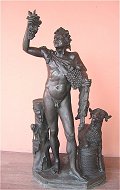SatyrMuseum Label: Chiurazzi description: |
Subject info:
The Faun is described in 1741 as having been excavated five years earlier, and
all early sources agree that it was found at Hadrian's Villa. It was
given to the Capitoline Museum in 1847 and was placed in a special room, named after it.
The sculpture was excavated by monsignor Furietti (remember the 2 Furietti centaurs in front of the Ringling Museum?), but it seems unlikely ever to have belonged to him.
The great reputation of the Faun was particularly due to the much admired variety of close-grained dark-red marble from which it was made. This marble was seldom found in large pieces and no other full-size figures made of it were then known. The quality of the carving was thought to be excellent. The Faun was also copied full size in marble by Cavaceppi and on a reduced scale in bronze by Righetti and Zoffoli.
The Faun is catalogued in Helbig as a copy, possibly made in the workshops of Aristeas and Papias (of the Fiuretti Centauri) of a bronze original.
What is a satyr or faun:
In Roman mythology, fauns are place-spirits (genii) of untamed woodland. Romans connected
their fauns with the Greek satyrs, wild and orgiastic drunken followers of Dionysus.
However, fauns and satyrs were originally quite different creatures. Both have horns and
both resemble goats below the waist, humans above; but originally satyrs had human feet,
fauns goatlike hooves. The Romans also had a god named Faunus and a goddess Fauna, who,
like the fauns, were goat-people.
Read more about Saryrs and Fauns here. A new window will open. Close after reading to come back here.
